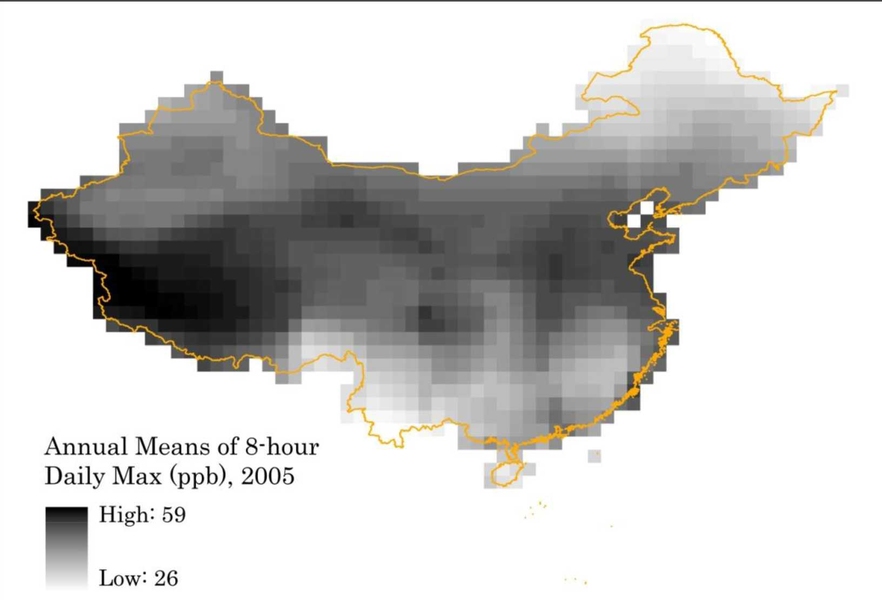China has experienced unprecedented development over the past three decades, but this growth has come at a substantial cost to the country’s environment and public health. China is notorious for extremely high levels of air pollution. As the country faces continuous environmental challenges that mirror its continuing development, there is a need to measure the health impacts of air pollution.
A recent study released by the MIT Joint Program on the Science and Policy of Global Change quantifies the damage to the Chinese economy caused by a lack of air-quality control measures between 1975 and 2005. Not surprisingly, the MIT researchers found that air pollutants produced a substantial socio-economic cost to China over the past three decades.
What makes this study unique is that researchers looked at long-term economic impacts that arise from health damages, and how pollution-induced morbidity and mortality cases may have had ripple effects on the Chinese economy beyond the time period when those cases actually occurred. This method creates a comprehensive picture of the cumulative impacts of air pollution on a dynamic, fast-developing country.
“This study represents a more accurate picture than previous studies of the air-pollution damages associated with rapid economic development in China,” says Noelle Selin, an assistant professor of engineering systems in MIT’s Engineering Systems Division, with a joint appointment in atmospheric chemistry in the Department of Earth, Atmospheric and Planetary Sciences. “A major advantage of this study over previous work is that it links state-of-the-art atmospheric modeling tools with a comprehensive global economic model incorporating health and economic damages from pollution.”
To observe how changes in pollutants, and their associated health impacts, have historically affected the Chinese economy, the MIT researchers modeled the number of cases of health incidences caused by air pollution — such as restricted-activity days, respiratory hospital admissions and asthma attacks, to name a few examples — given a pollution level and the number of people exposed. Then the model calculated the summed costs of these incidences — i.e., payments for health services and medicine, loss of labor and productivity from time off work, loss of leisure time needed for healing — to estimate the total change in available labor supply.
The study focused on two major air pollutants: particulate matter and ozone. Levels of particulate matter, which causes respiratory and cardiovascular diseases and accounts for a large fraction of damage to human health, are extremely high in China. In the 1980s, particulate matter concentrations were at least 10-16 times higher than the World Health Organization’s annual guidelines. Even in 2005, after significant improvements in Chinese air quality, concentrations were still about five times higher than the guidelines.
China has only recently begun monitoring levels of the second air pollutant, ozone. Chinese ozone data does not exist between 1970 and 2005, the period considered in this study. In fact, most air pollution studies of China omit the pollutant completely due to lack of data. However, the MIT study incorporates historical ozone levels over the past three decades as simulated by GEOS-Chem (a chemical transport model) and MIT’s Integrated Global Systems Model, thus significantly improving on previous studies of pollution damage.
The researchers found that, although the magnitude of air pollution in China decreased over the three decades, damages associated with the pollutants created a substantial burden on the Chinese economy. “The results clearly indicate that ozone and particulate matter have substantially impacted the Chinese economy over the past 30 years,” Selin says.
When comparing historical pollution levels and the associated impacts with a counterfactual scenario in which pollutants were restricted to background levels, or the best attainable air quality standards, China experienced an increasing loss in welfare — from $22 billion lost in 1975 to $122 billion lost in 2005 — from pollution-related health impacts.
There are two main reasons for the increasing loss in welfare, despite reduced levels of pollution between 1975 and 2005. First, rapid urbanization and growth increased the number of people exposed. Second, productivity of labor increases over time so that costs from lost labor are higher in recent times than in periods in the past. These factors outweigh the small improvements in air quality.
If a modest, feasible level of air-pollution control measures had been implemented over the time period, China would have reaped an increasing benefit in welfare — potentially growing from $18 billion gained in 1975 to $80 billion in 2005.
Similar studies conducted by the World Bank have found that air pollution in China caused damages equal to 4-5 percent of the Chinese GDP between 1995 and 2005. However, these estimates are based on static measurements that do not measure the cumulative, long-term impacts of health damages. The MIT study found a significantly higher level of damage, equaling 6-9 percent of the Chinese GDP. The dynamic, cumulative method used in the MIT study may be particularly applicable to developing countries that are experiencing rapid growth.
The MIT study looked at the benefits of air-quality controls on health damages in China, but did not calculate the costs of implementing such policies. Future work will focus on the costs of pollution controls so that a complete cost-benefit analysis can be developed.
A recent study released by the MIT Joint Program on the Science and Policy of Global Change quantifies the damage to the Chinese economy caused by a lack of air-quality control measures between 1975 and 2005. Not surprisingly, the MIT researchers found that air pollutants produced a substantial socio-economic cost to China over the past three decades.
What makes this study unique is that researchers looked at long-term economic impacts that arise from health damages, and how pollution-induced morbidity and mortality cases may have had ripple effects on the Chinese economy beyond the time period when those cases actually occurred. This method creates a comprehensive picture of the cumulative impacts of air pollution on a dynamic, fast-developing country.
“This study represents a more accurate picture than previous studies of the air-pollution damages associated with rapid economic development in China,” says Noelle Selin, an assistant professor of engineering systems in MIT’s Engineering Systems Division, with a joint appointment in atmospheric chemistry in the Department of Earth, Atmospheric and Planetary Sciences. “A major advantage of this study over previous work is that it links state-of-the-art atmospheric modeling tools with a comprehensive global economic model incorporating health and economic damages from pollution.”
To observe how changes in pollutants, and their associated health impacts, have historically affected the Chinese economy, the MIT researchers modeled the number of cases of health incidences caused by air pollution — such as restricted-activity days, respiratory hospital admissions and asthma attacks, to name a few examples — given a pollution level and the number of people exposed. Then the model calculated the summed costs of these incidences — i.e., payments for health services and medicine, loss of labor and productivity from time off work, loss of leisure time needed for healing — to estimate the total change in available labor supply.
The study focused on two major air pollutants: particulate matter and ozone. Levels of particulate matter, which causes respiratory and cardiovascular diseases and accounts for a large fraction of damage to human health, are extremely high in China. In the 1980s, particulate matter concentrations were at least 10-16 times higher than the World Health Organization’s annual guidelines. Even in 2005, after significant improvements in Chinese air quality, concentrations were still about five times higher than the guidelines.
China has only recently begun monitoring levels of the second air pollutant, ozone. Chinese ozone data does not exist between 1970 and 2005, the period considered in this study. In fact, most air pollution studies of China omit the pollutant completely due to lack of data. However, the MIT study incorporates historical ozone levels over the past three decades as simulated by GEOS-Chem (a chemical transport model) and MIT’s Integrated Global Systems Model, thus significantly improving on previous studies of pollution damage.
The researchers found that, although the magnitude of air pollution in China decreased over the three decades, damages associated with the pollutants created a substantial burden on the Chinese economy. “The results clearly indicate that ozone and particulate matter have substantially impacted the Chinese economy over the past 30 years,” Selin says.
When comparing historical pollution levels and the associated impacts with a counterfactual scenario in which pollutants were restricted to background levels, or the best attainable air quality standards, China experienced an increasing loss in welfare — from $22 billion lost in 1975 to $122 billion lost in 2005 — from pollution-related health impacts.
There are two main reasons for the increasing loss in welfare, despite reduced levels of pollution between 1975 and 2005. First, rapid urbanization and growth increased the number of people exposed. Second, productivity of labor increases over time so that costs from lost labor are higher in recent times than in periods in the past. These factors outweigh the small improvements in air quality.
If a modest, feasible level of air-pollution control measures had been implemented over the time period, China would have reaped an increasing benefit in welfare — potentially growing from $18 billion gained in 1975 to $80 billion in 2005.
Similar studies conducted by the World Bank have found that air pollution in China caused damages equal to 4-5 percent of the Chinese GDP between 1995 and 2005. However, these estimates are based on static measurements that do not measure the cumulative, long-term impacts of health damages. The MIT study found a significantly higher level of damage, equaling 6-9 percent of the Chinese GDP. The dynamic, cumulative method used in the MIT study may be particularly applicable to developing countries that are experiencing rapid growth.
The MIT study looked at the benefits of air-quality controls on health damages in China, but did not calculate the costs of implementing such policies. Future work will focus on the costs of pollution controls so that a complete cost-benefit analysis can be developed.






